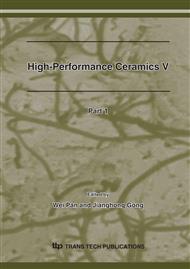[1]
K. Miyoshi, E. Morikuni, K. Fujiwara, et al.: Phys. Rev. B. Vol. 69 (2004), P. 132412.
Google Scholar
[2]
J. Nan, J. Wu and Y. Deng, et al.: J. Eur. Ceram. Soc. Vol. 23 (2003), p.859.
Google Scholar
[3]
J.D. Ye, S.L. Gu and F. Li, et al.: Appl. Phys. Lett. Vol. 90 (2007), p.152108.
Google Scholar
[4]
K.F. Cai, E. Mueller, C. Drasar, et al.: Mater. Lett. Vol. 57 (2003), p.4251.
Google Scholar
[5]
Y. Tanaka, T. Ifuku and K. Tsuchida: J. Mater. Sci. Lett. Vol. 16 (1997), p.155.
Google Scholar
[6]
J.W. Elam, Z.A. Sechrist, and S.M. George: Thin Solid Film, Vol. 414 (2002), p.43.
Google Scholar
[7]
K. Park and Y. Ko: J. Alloys. Compd. Vol. 430 (2007), p.200.
Google Scholar
[8]
M. Kazeoka, H. Hiramatsu, W.S. Seo, et al.: J. Mater. Res. Vol. 13(3) (1998), p.523.
Google Scholar
[9]
M. Ohtaki, T. Tsubota and K. eguchi: J. Appl. Phys. Vol. 79(3) (1996), p.1816.
Google Scholar
200 400 600 800 1000.
Google Scholar
[5]
[10] [15] [20] [25] [30] cold pressing CIP κ(W/m/K) Temperature(oC) (a).
Google Scholar
200 400 600 800 1000.
Google Scholar
[2] [4] [6] [8] [10] [12] [14] cold pressing CIP κ(W/m/K) Temperature(oC) (b).
Google Scholar
200 400 600 800 1000 0. 0 0. 2 0. 4 0. 6 0. 8 1. 0 1. 2 δ(S/cm) Temperature (oC) CIP cold pressing (c).
Google Scholar
200 400 600 800 1000.
Google Scholar
[2] [4] [6] [8] [10] Temperature (o C) cold pressing δ(S/cm) CIP (d) Fig. 4 (a) Thermal conductivity of pure ZnO ceramics, (b) 3wt% Al2O3-doped ZnO ceramics after cold pressing and CIP, respectively, (c) Electrical conductivity of pure ZnO ceramics, (d) 3wt% Al2O3-doped ZnO ceramics after cold pressing and CIP, respectively.
DOI: 10.1016/j.ceramint.2006.01.006
Google Scholar
200 400 600 800 1000 0. 00 0. 05 0. 10 0. 15 0. 20 0. 25 0. 30 0% δ(S/cm) Temperature ( o C) 1% 3% (a).
Google Scholar
200 400 600 800 1000.
Google Scholar
[5]
[10] [15] [20] [25] κ(W/mK) Temperature(oC) (b) 0% 1% 3% Fig. 3 Temperature dependence of (a) electrical conductivity; (b) thermal conductivity of the samples sintered at 1000 o C after cold pressing with different amounts of Al2O3.
Google Scholar


